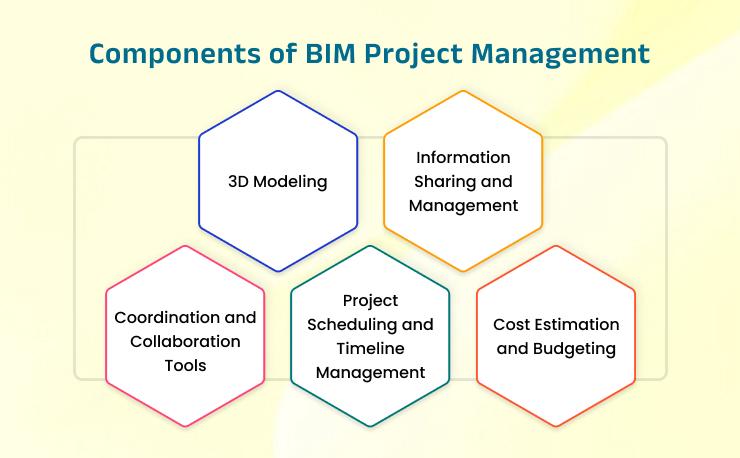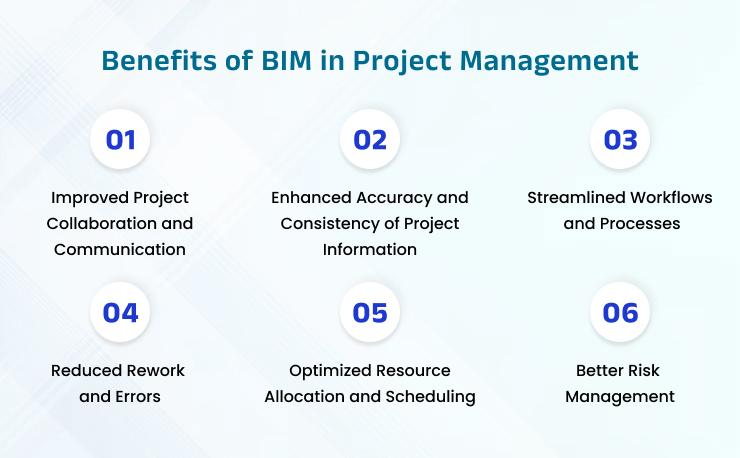
BIM Project Management: An Ultimate Guide
Building Information Modeling (BIM) is a transformative approach in the construction industry that uses digital technologies to create accurate virtual models of buildings. BIM encompasses the entire lifecycle of a project, from planning and design to construction and maintenance, enabling better collaboration and decision-making.
Originating in the 1970s, BIM has evolved to become a cornerstone of modern construction practices, offering a range of benefits that traditional methods cannot match. Let’s review the complete BIM Project Management Guide to learn more about it.
What is BIM?
Building Information Modeling (BIM) is a digital process that uses 3D models and associated data to manage the planning, design, construction, and operation of buildings and infrastructure. Unlike traditional 2D drafting, BIM incorporates detailed information about every aspect of a building’s lifecycle, from initial design and construction to maintenance and eventual demolition.
Why Use BIM for Project Management?
Improved Collaboration and Communication
BIM facilitates seamless collaboration among all stakeholders by providing a shared platform for project data. Architects, engineers, contractors, and owners can access and update information in real-time, reducing miscommunications and ensuring everyone is on the same page.
Enhanced Project Visualization
With BIM, project teams can create detailed 3D models that offer a realistic view of the final product. This visualization aids in identifying potential issues early in the design phase, allowing for adjustments before construction begins.
Increased Efficiency and Productivity
BIM streamlines project workflows by integrating various aspects of design, analysis, and documentation. Automated processes reduce manual work, speeding up project timelines and increasing overall productivity.
Better Project Outcomes and Quality Control
BIM’s detailed models allow for thorough analysis and simulation, ensuring that projects meet high standards of quality and performance. This leads to better-built structures and fewer issues post-construction.
Reduced Costs and Minimized Errors
By catching design errors and clashes early, BIM reduces the likelihood of costly rework during construction. Accurate cost estimation and budgeting tools within BIM also help keep projects within financial constraints.
Components of BIM Project Management
3D Modeling
BIM relies on creating accurate three-dimensional representations of buildings, providing a comprehensive visual and spatial understanding of the project.
Information Sharing and Management
Centralized data management ensures that all project information is stored in one place accessible to all stakeholders. This improves data integrity and reduces the risk of information loss.
Coordination and Collaboration Tools
BIM software includes tools for coordinating various aspects of a project, from design to construction. These tools help manage workflows, schedules, and resource allocation efficiently.
Project Scheduling and Timeline Management
BIM integrates project scheduling (4D BIM), allowing for the visualization of construction sequences over time. This helps Scan to BIM effectively plan and track project timelines.
Cost Estimation and Budgeting
5D BIM incorporates cost data into the model, enabling accurate budgeting and financial management throughout the project lifecycle.
Steps to Implement BIM Methods in Project Management
- Assessment of Current Processes and Readiness Evaluate existing workflows and determine the organization’s readiness to adopt BIM. Identify areas that need improvement and plan for the transition.
- Setting Clear Goals and Objectives Define what you aim to achieve with BIM implementation, such as improved efficiency, better collaboration, or enhanced project quality.
- Selecting the Right BIM Tools and Software Choose BIM software that best fits your project requirements and budget. Consider factors like user-friendliness, compatibility with existing systems, and support services.
- Training and Skill Development for Team Members: Provide comprehensive training to ensure that all team members are proficient in using BIM tools. Continuous education and skill development are crucial for maximizing BIM benefits.
- Developing a BIM Execution Plan (BEP) Create a detailed plan outlining how BIM will be implemented, including roles and responsibilities, processes, and standards to be followed.
- Implementing BIM in Phases: Start with a pilot project to test BIM processes and tools. Gradually scale up to larger projects as you gain experience and confidence.
- Monitoring, Evaluation, and Continuous Improvement: Regularly review BIM implementation progress, gather feedback, and make necessary adjustments. Continuous improvement is key to successful BIM adoption.
Benefits of BIM in Project Management
Improved Project Collaboration and Communication
BIM’s centralized data platform enhances communication and collaboration among all project stakeholders, leading to more coordinated and efficient project execution.
Enhanced Accuracy and Consistency of Project Information
BIM ensures that all project data is accurate and up-to-date, reducing discrepancies and ensuring that everyone works with the same information.
Streamlined Workflows and Processes
BIM integrates various project workflows, from design to construction, making processes more efficient and reducing duplication of efforts.
Reduced Rework and Errors
By identifying and resolving issues early in the design phase, BIM minimizes errors and reduces the need for rework during construction, saving time and money.
Optimized Resource Allocation and Scheduling
BIM helps in planning and managing resources more effectively, ensuring that materials, labor, and equipment are used optimally.
Better Risk Management
BIM’s ability to simulate and analyze different scenarios helps identify potential risks and develop mitigation strategies, leading to safer and more reliable projects.
Top 5 Software for BIM
1. Autodesk Revit
Autodesk Revit is a comprehensive BIM solution that supports all phases of a building project, from conceptual design through construction and maintenance. It offers powerful tools for 3D modeling, coordination, and documentation, making it ideal for multidisciplinary project teams. Revit enhances collaboration with cloud-based workflows and integrates seamlessly with other Autodesk products.
2. Navisworks
Navisworks is a project review software that facilitates the integration of various design data formats, enabling comprehensive project coordination and clash detection. It allows teams to simulate construction sequences and visualize project timelines, ensuring that potential issues are identified and resolved before construction begins. Navisworks improves communication among stakeholders through real-time model review and markup tools.
3. Bentley Systems
Bentley Systems offers a range of BIM applications specifically designed for infrastructure projects, supporting advanced modeling, simulation, and analysis. Their software suite includes tools for civil engineering, transportation, and utilities, providing robust solutions for complex infrastructure challenges. Bentley’s applications enhance project efficiency and accuracy through detailed 3D models and comprehensive data integration.
4. ArchiCAD
ArchiCAD is a BIM software tailored for architects, providing powerful tools for designing, visualizing, and documenting buildings efficiently. It features an intuitive interface and supports collaborative workflows, allowing architects to focus on creativity while ensuring precision in documentation. ArchiCAD also integrates well with other design and analysis tools, making it a versatile choice for architectural projects.
5. Tekla Structures
Tekla Structures specializes in detailed structural design and construction, enabling accurate modeling and collaboration for complex projects. It supports the creation of precise and constructible models, facilitating better coordination between structural engineers and other stakeholders. Tekla’s advanced tools for analysis and detailing help ensure the integrity and feasibility of structural designs throughout the project lifecycle.
Challenges and Solutions
Initial Cost and Investment
- Challenge: High initial costs for software, training, and hardware.
- Solution: Conduct an ROI analysis to justify the investment and implement BIM in phases to spread out costs.
Resistance to Change
- Challenge: Resistance from staff and stakeholders accustomed to traditional methods.
- Solution: Provide comprehensive training and involve stakeholders in the transition process to ensure buy-in and smooth adoption.
Data Management and Integration
- Challenge: Managing and integrating large volumes of data from different sources.
- Solution: Standardize data formats and use interoperable tools to ensure seamless data integration and management.
Software Interoperability Issues
- Challenge: Incompatibility between different BIM tools and software.
- Solution: Select compatible tools and establish clear protocols for data exchange to ensure smooth interoperability.
Legal and Contractual Issues
- Challenge: Updating contracts to include BIM requirements and managing legal aspects.
- Solution: Work with legal experts to revise contracts and ensure that all BIM-related responsibilities and deliverables are clearly defined.
Best Practices for BIM Project Management
- Develop a Clear BIM Strategy and Roadmap: Define your BIM goals and create a detailed roadmap for implementation, ensuring alignment with overall project objectives.
- Ensure Top-Down Support and Commitment: Obtain commitment from senior management and ensure that BIM adoption is supported at all levels of the organization.
- Invest in Ongoing Training and Professional Development: Continuous education and training are essential to keep up with evolving BIM technologies and practices.
- Foster a Collaborative Culture: To maximize the benefits of BIM, encourage collaboration and open communication among all project stakeholders.
- Regularly Update and Review the BIM Execution Plan (BEP): Keep the BEP up-to-date with project changes and new developments, ensuring that it remains relevant and effective.
- Utilize Cloud-Based Solutions for Real-Time Collaboration: Leverage cloud-based BIM tools to facilitate real-time collaboration and data sharing among geographically dispersed teams.
Future Trends in BIM Project Management
The integration of BIM with IoT devices and smart building technologies will enable real-time monitoring and management of building performance, providing valuable insights and optimizing operations. Advancements in AI and machine learning are set to enhance BIM capabilities by offering predictive analytics for better decision-making and risk management.
The greater adoption of augmented reality (AR) and virtual reality (VR) technologies will offer immersive project visualization, significantly improving design review processes and stakeholder engagement. Enhanced capabilities in 4D (time) and 5D (cost) BIM will provide more comprehensive project management tools, enabling better planning and control.
Additionally, the expansion of BIM to facility management and the entire building lifecycle will offer a holistic approach to building management and maintenance, ensuring long-term efficiency and sustainability.
Ready to revolutionize your construction projects with BIM?
Embrace the future of project management with our expert BIM services. Improve collaboration, reduce costs, and enhance project outcomes today.
Conclusion
BIM is revolutionizing project management in the construction industry, offering numerous benefits, from improved collaboration to enhanced project outcomes. By adopting BIM, organizations can achieve greater efficiency, reduce costs, and deliver higher-quality projects. The future of BIM looks promising, with ongoing advancements and new applications continuing to drive innovation in project management.
FAQ
What is BIM Project Management?
BIM project management involves using Building Information Modeling (BIM) processes and tools to plan, design, construct, and manage building projects. It integrates all project data into a single digital model, facilitating better collaboration, improved accuracy, and more efficient project execution.
What are the 4 Stages of BIM?
- Design: Creation of the initial 3D model, including architectural, structural, and MEP (mechanical, electrical, plumbing) designs.
- Construction: Detailed planning and coordination of the construction process, utilizing the BIM model for clash detection and scheduling.
- Operation: Management and maintenance of the building using data from the BIM model to optimize performance and efficiency.
- Decommissioning: Planning for the end of the building’s lifecycle, including demolition or repurposing, based on BIM data.
What are the 5 Steps of BIM?
- Assessment: Evaluate current processes and determine readiness for BIM adoption.
- Planning: Define clear goals and objectives and develop a BIM Execution Plan (BEP).
- Implementation: Choose appropriate BIM tools, train team members, and start with a pilot project.
- Execution: Integrate BIM processes into project workflows, focusing on collaboration and data management.
- Monitoring and Improvement: Continuously monitor BIM use, gather feedback, and make adjustments for continuous improvement.
What is the Role of BIM as a Project Planner?
As a project planner, BIM plays a critical role in visualizing the project from start to finish, ensuring accurate and detailed planning. It helps in identifying potential issues early, coordinating between different stakeholders, optimizing resource allocation, and managing project timelines and costs effectively. BIM enhances decision-making and improves overall project outcomes by providing a comprehensive and integrated view of the entire project lifecycle.




